|
"In some parts of
the world, people cut holes in their lips for the insertion of plugs or
buttons. To such ornaments the name labret is frequently given"------1926,
Clark Wissler, "The Relation Of Nature To Man In Aboriginal America,"
p. 61.
"The labret, among American aborigines, is well
known to be a plug, stud or variously-shaped button, made from various
materials, which is inserted at or about the age of puberty through a
hole or holes pierced in the thinner portions of the face about the
mouth."--------1884,
W. H. Dall, "On Masks, Labrets, And Certain Aboriginal Customs,
With An Inquiry Into The Bearing Of Their Geographical Distribution,"
Third Annual Report Of The Bureau Of Ethnology To The Secretary Of
The Smithsonian Institution, pp. 77-78.
"They (labrets)
are worn in some tribes by women only, in others by men only, in still
others by both sexes, in which case the style of the labret is different
for each sex."----1884,
W. H. Dall, "On Masks, Labrets, And Certain Aboriginal Customs,
With An Inquiry Into The Bearing Of Their Geographical Distribution,"
Third Annual Report Of The Bureau Of Ethnology To The Secretary Of
The Smithsonian Institution, p. 78.
"The
first descriptions by Europeans (in
1741) of the use by Alaskan peoples of tattoo
and labrets refer to the Aleuts and Pacific Eskimos."----1988,
Joy Gritton, "Labrets And Tattooing In Native Alaska,"
Marks Of Civilization, p. 181.
"Labrets (in
Alaska) could be made of a variety of materials: stone (quartz, agate,
jadite, serpentine or slate), graphite, glass, bone, wood or ivory."----1988,
Joy Gritton, "Labrets And Tattooing In Native Alaska,"
Marks Of Civilization, p. 186.
"The decline of
these two permanent modes of adornment (labrets
& tattooing) has generally been
attributed to intense efforts on the part of Christian missionaries to
eradicate aspects of dress, grooming, and ritual they found offensive."----1988,
Joy Gritton, "Labrets And Tattooing In Native Alaska,"
Marks Of Civilization, p. 181.
"The world
distribution of labrets is very limited. From my observations
independent development of labrets seems to be a rare occurrence.
Labrets originate and disperse from a maximum of six localities in the
world."----1989,
Grant Keddie, "Symbolism And Context: The World History Of The
Labret And Cultural Diffusion On The Pacific Rim," p. 7.
"I refer to
the use of labrets, which for brevity may be called labretifery."---------1884,
W. H. Dall, "On Masks, Labrets, And Certain Aboriginal Customs,
With An Inquiry Into The Bearing Of Their Geographical Distribution,"
Third Annual Report Of The Bureau Of Ethnology To The Secretary Of
The Smithsonian Institution, p. 77.

LABRETS
(WORLDWIDE DATE)
10,700 YEARS AGO TO PRESENT DAY
ALASKA, MEXICO, PERU
Labrets are items of adornment that were
worn around the mouth in patterns of one or more separate pieces. They
are held in place with a flanged or flared edge. Labrets are placed
through a hole that is pierced through the skin either above or below
the lips or at the corners of the mouth. The archaeological record
suggests they "may have been" independently invented in six locations around the
world at the southern
Kamchatka Peninsula in Siberia, Iran, the Balkans, Sudan in Africa,
southwestern Mexico and in Ecuador.
The use of labrets spread outward from these locations to more
distant groups of people through trade and marriage alliances. |
|
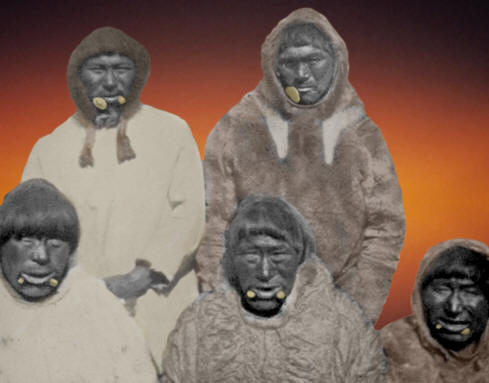
Computer colorized image from the 1899
"Eighteenth Annual Report Of The Bureau Of Ethnology
To The Secretary Of
The Smithsonian Institution, p. 64.
MEN AND WOMEN WEARING LABRETS
KOTZEBUE SOUND, ALASKA
This picture was taken over a hundred
years ago of people from Kotzebue Sound in northwestern Alaska. They
wear different sizes of labrets that vary in size from half an inch to nearly two
inches in diameter. The people in this region made their labrets out
of granite, syenite, jadite, quartz, slate, glass, lignite, wood,
walrus tusk and fossil mammoth ivory. |
|
|
The earliest use of labrets appears to have been in either
Iran at approximate 8400 years ago or at the southern Kamchatka
Peninsula in Siberia where Dikov suggests a date of 10700 for labrets he
discovered in level VI on the Ushki I site. Labrets appear in Iraq 7000
years ago. They also appear in the Balkans 7000 years ago, where they
lasted for a thousand years. They appear in the Nile Valley 5300 years
ago. Labrets appear in Africa in central Sudan 5300 years ago where they
spread outward to Chad, Mali, Congo, Nigeria, etc.
Labrets first appear in southwestern Mexico sometime between 3500
and 3350 years ago along the coast of Chiapas and 200 years later in the
Tehuacan Valley. In South America, labrets first appear in Ecuador 2500
years ago and 200 years later they appear in Peru with the Mochica culture. |
|
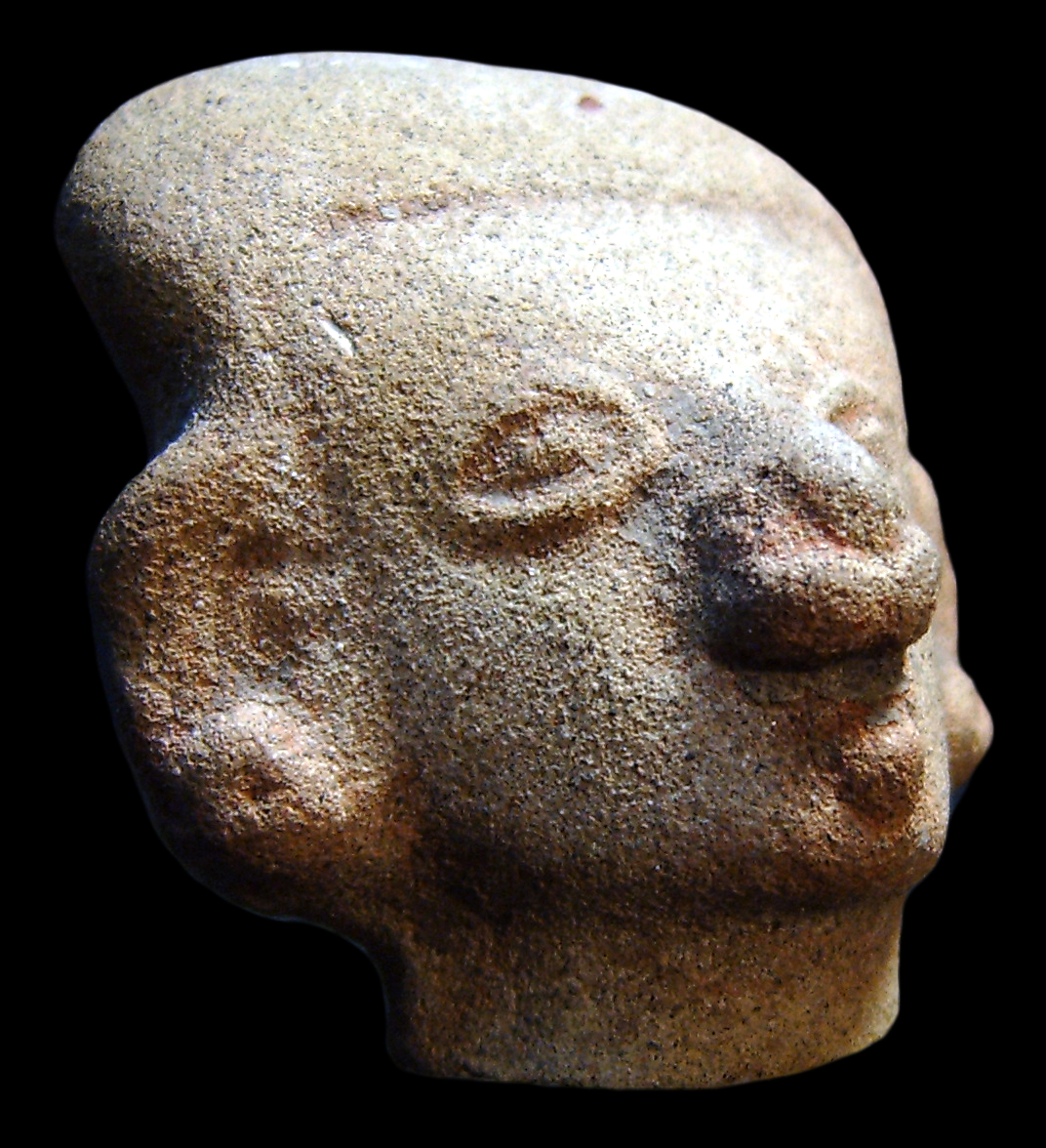
STONE CARVED HEAD
ECUADOR
This image illustrates the
use of labrets in Ecuador sometime in the distant past. Labrets first
appear in the coastal area of Ecuador approximately 2500 years ago.
Their use in this area may have been influenced by maritime contacts
from areas farther to the north along the west coast of Mexico. |
|
|
Labrets were made from almost every type of raw material that
could be shaped by carving, grinding, hammering, casting and polishing.
Some of the materials that have been used by early period cultures
include bone, coal, copper, glass, gold, ivory, shell, silver, wood and
various types of stones, such as quartz, agate, jadite, serpentine,
slate and other exotic stones. |
|
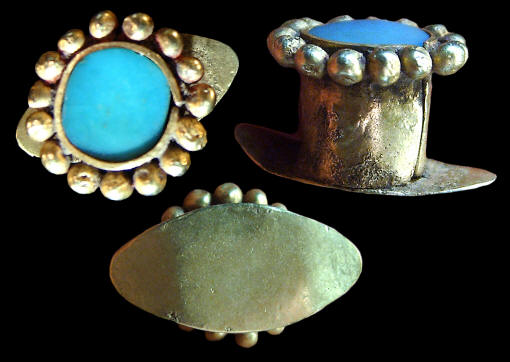
PRIVATE COLLECTION
CLICK ON PICTURE FOR LARGER IMAGE
GOLD LABRET
MOCHE CULTURE
PERU
Labrets appear in the Mochica culture in Peru approximately 2300
years ago. They began to be used about 200 years after they appear
in Ecuador. It's believed they were introduced into Peru from either Ecuador
or western Mexico. This gold labret was made by a highly skilled Moche
craftsmen. The Mochica people are famous for their metalwork,
especially gold, but they also used copper and silver. Their most
impressive gold work is in the form of headdress ornaments which can
range in size up to twelve inches high and fifteen inches wide. This
gold labret is decorated around the rim with gold balls and inlayed
with a beautiful blue stone called chrysocolla. |
|
|
Most labrets were made out of common materials in the shape of
simple plugs. The more finely crafted and rarer
materials were worn by elite individuals. As an example, Purchas writes
about the people in the valley of Mexico in 1626, "Among the rest
of rather aloofe off (upper class) from the rest (of the Mexicans met by
Cortez) were certain Indians of differing habit, higher than the other
and had the gristles of their noses slit, hanging over their mouths, and
rings of jet and amber hanging thereat; their nether (lower) lips also
bored and in the holes rings of gold and Trukese-stones (Turquoise)
which weighed so much that their lips hung over their chins leaving
their teeth bare." |
|
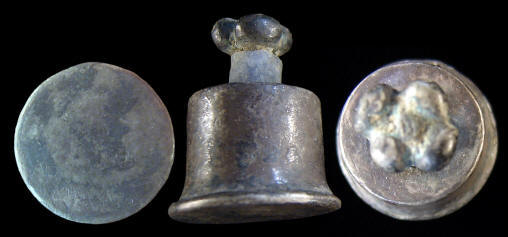
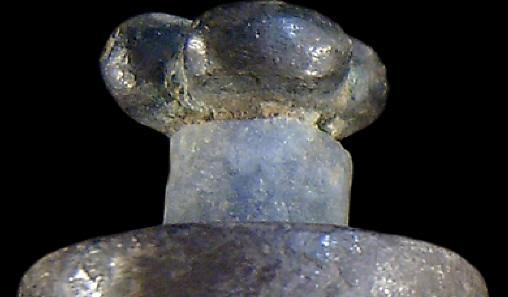
PRIVATE COLLECTION
CLICK ON PICTURE FOR LARGER IMAGE
SILVER LABRET
MOCHE CULTURE
PERU
This labret was produced by a skilled
Moche metal craftsman sometime after 2300 years ago in Peru. It
illustrates the outstanding quality they were able to achieve with
primitive tools. This labret is mainly constructed of silver with
the addition of a small quartz ring around what appears to be a stem
under some type sculpted plant or flower. |
|
|
Labrets were usually acquired when the person was very young,
around the age of puberty. Spencer describes the procedure of how a
young boy in the region north of the Yukon acquired his first labret at
the age when his voice changed. The operation was done by an older man
who was not paid but was skilled in this type of procedure. The boy
leaned back into the man's lap, with his hands over his ears, and a
piece of wood was placed into his mouth against which a slate knife was
driven through the flesh. The wound was washed out with urine then a
cylindrical ivory pin with a flange on one end was inserted through the
fresh wound. As a person grew older, smaller labrets were often replaced
with larger ones that would stretch the skin a little more each time. |
|

PRIVATE COLLECTION
CLICK ON PICTURE FOR LARGER IMAGE
OBSIDIAN LABRET
CENTRAL VALLEY OF MEXICO
Labrets first appear in Mexico sometime between 3500 and 3350 years
ago along the coast of Chiapas in southwestern Mexico. This labret
is believed to have been collected in the Central Valley of Mexico
where they first appear about 2900 years ago. This labret is made of
semi-translucent green Obsidian. It's surface has been polished to a
mirror finish. It measures 3/4 of an inch (1.9 cm) wide. |
|
|
In Alaska and in Mesoamerica there were no one set of rules
for the use of labrets. Gender, social status and age were three of the
most important factors that determined how any one person would wear
their labret. The size of a labret could indicate the age of a person
while the color or rarity of an inlayed stone could indicate the persons
social status. In some areas in Alaska only women wore them, while in
other areas only men wore them. But in other areas both men and women
wore them. |
|

PRIVATE COLLECTION
CLICK ON PICTURE FOR LARGER IMAGE
COAL LABRET
ALASKA
Labrets are believed to have spread
to the eastern north Pacific sometime after 5500 years ago. Some of
the earliest labrets in North America were found just south of
Vancouver on Pender Island. They date to at least 5100 years ago.
This labret was collected in western Alaska but it's also similar to
labrets that have been found on the southern coast of British
Columbia that date to between 5000 and 2000 years ago. This labret
is made of coal. It measures 7/8
of an inch (2.3 cm) wide. |
|
|
Labrets were made in an endless variety of shapes and sizes
that varied with each locality. Along the northwest coast the Tlingit
women wore labrets up to 4 inches (10 cm) wide. In the region farther to
the north in the Arctic, people wore labrets up to 2 inches (5 cm) in
diameter. One report describes a labret that was almost 4 3/4 inches
(11.9 cm) in diameter and weighed 7 ounces. The weight of these larger
stone labrets would drag down the lip so the lower teeth and gums were
exposed. |
|
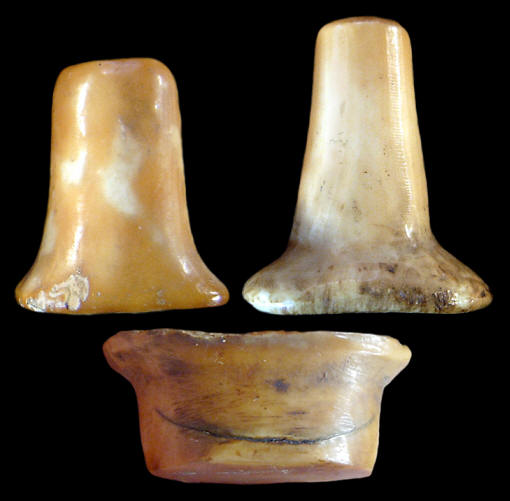
CLICK ON PICTURE FOR LARGER IMAGE
BONE & IVORY LABRETS
ALASKA
These three labrets are typical
examples. These types have been found on sites in western Alaska and
down the coast to
British Columbia. The narrower ends project through the holes around
the mouth and the wider ends hold the labret securely inside the
mouth. The longest example is made of ivory and it measures 7/8 of
an inch (2.2 cm) long. |
|
|
The use of the largest labrets in the northwestern United States had
almost disappeared by the mid-1800's and the use of all labrets in this
region began to fade rapidly by the beginning of the 1900's. This change
in cultural tradition was strongly influenced by the intense efforts of
Christian missionaries to alter the indigenous peoples way of dress,
grooming and rituals. Although the Europeans exhibited extreme and
negative reactions to the use of labrets, especially the largest
examples, the native people saw them as a perfectly honorable tradition.
But outside influences always cause some form of change and in this case
the labrets did not survive. But in Brazil and in central Africa some
tribal groups still hold onto this very unique form of ornamental
display. |
|
"REFERENCES"
1884, Dall, William H., "On Masks, Labrets, And Certain Aboriginal Customs,
With An Inquiry Into The Bearing Of Their Geographical Distribution,"
Third Annual Report Of The Bureau Of Ethnology To The Secretary Of
The Smithsonian Institution, 1881-82, pp. 77-78.
1899, Nelson, Edward William, "The Eskimo About Bering Strait,"
Eighteenth Annual Report Of The Bureau Of Ethnology To The Secretary Of
The Smithsonian Institution, 1896-97, pp. 77-78.
1926, Wissler, Clark, "The Relation Of Nature To Man In Aboriginal America,"
p. 61-67.
1959, Spencer, Robert F., "The North Alaskan Eskimo," Bureau Of
American Ethnology, Bulletin, 171, pp. 241-242.
1979, Jones, Julie, "Mochica Works Of Art In Metal,"
Pre-Columbian Metallurgy Of South America, pp. 53-1.4.
1988, Gritton, Joy, "Labrets And Tattooing In Native Alaska,"
Marks Of Civilization, p. 181-190.
1989, Keddie, Grant, "Symbolism And Context: The World History Of The
Labret And Cultural Diffusion On The Pacific Rim," p. 7.
Personal Communication with Tony Stein.
|
|
RECENT
LISTINGS HOME
ORDERING |